Pilot waves
In his initial work in 1925, de Broglie [ref 1] proposed for elementary particles (such as an electron) a structure that was meant to account for their dual character. In his model a particle of rest mass m0 has an oscillation at the Compton frequency ν0 = m0c2/h and forms a singular region in a wave field of wavelength λdB=h/mV. This is a standing wave field that results from the superposition of an emitted wave radiated away (retarded wave) and a wave converging towards the particle (advanced wave). The particle is guided by the wave, its velocity being proportional to the gradient of the wave phase. Such an association of the particle to a wave field was meant to introduce the possibility of non-newtonian behaviours. This was summarized by de Broglie in the following terms : "the particle’s motion (...) guided by the wave (...) would not follow the laws of classical mechanics according to which the particle is subject only to the action of forces which act on it along its trajectory, and does not suffer any repercussion from the existence of obstacles which may be situated far away outside its trajectory. In my (. . . ) conception, on the contrary, the movement of the singularity should experience the influence of all the obstacles which hinder the propagation of the wave with which it is connected. This circumstance would explain the existence of the phenomena of interference and diffraction."Inspired by this work, Schrödinger initially introduced the equation that carries his name while seeking de Broglie’s wave. It was only later that Born demonstrated that the Schrödinger equation was related to the probability of presence. De Broglie then suggested in 1927 [ref 2] that in all quantum systems two wave fields have to be considered.
A first wave-field (that he called u) is generated by the particle. It is a physical wave that has a singularity at its core. (In later versions he proposed that the core region could be strongly non-linear). For de Broglie this wave-particle structure had well-defined trajectories in the physical space. The particle could be submitted to forces but its association to the wave also gave it a non-local sensitivity to the environment and a non-Newtonian behaviour. The second wave-field is ψ the linear and smooth solution of the Schrödinger equation that is related to the statistical density of probability of presence.
Much later, in 1952, David Bohm [ref 3] revisited the idea of a pilot wave and investigated the situation where the wave solution of the Schrödinger equation would be the pilot wave. Bohm used the Madelung transformation of the Schrödinger equation to obtain an equation of motion where a velocity was defined from the gradient of the phase of the Schrödinger wave function. This equation is similar to that proposed by de Broglie, but deceptively so, since these two equations are related to two different wave fields (u and ψ, respectively). In the Bohmian model where the wave function is decoupled from the trajectory itself, a slightly modified Newtonian mechanics can be recovered by addition of a "quantum potential".
The Bohmian trajectories, being computed from Schrödinger’s equation, are necessarily the trajectories of probability densities, rather than those of individual particles. This is the reason for which de Broglie wrote shortly after Bohm’s publication [ref 4] : ". . . David Bohm took up the pilot-wave theory again. His work is very interesting in many ways (...) But since Bohm’s theory regards the wave ψ as a physical reality, it seems to me to be unacceptable in its present form." This led de Broglie to restate in 1959 [ref 5] his "double solution" hypothesis where a wave field u is associated to a given particle and guides its motion.
The recent development of the Bohmian approach has permitted the computation [ref 6], then the experimental observation of trajectories in e.g. interference and diffraction of particle beams [ref 7,8]. Naturally these are trajectories of maximum of probabilities, not those of individual particles. In contrast, little progress was done through the use of de Broglie’s model. The u waves were never detected and it remained unclear how they could generate the random behaviours responsible for the statistics.
As was noted in part III, our system seems a laboratory implementation at macroscopic scale of the idea of the de Broglie type of pilot waves [see P15-P16 & ref 6]. It has however one additional asset absent from de Broglie model : the fact that the wave field contains a memory of the particle trajectory. The previous results, particularly those demonstrating the intermittency phenomena [P20] show that statistical behaviours are observed in this system. Is it possible to go one step further : can wave-like probabilities show-up in our system ? Even though no theoretical model have yet come to demonstrate it, several experiments and numerical simulations, detailed below, show that such is the case.
Confinement
In the experiments presented in section V a force was applied to the droplet. In the experiments to be discussed here no force is exerted directly on to the droplet but its wave-field is disturbed, using sub-marine walls. The propulsion of a walker’s droplet requires that its bouncing triggers Faraday waves. The acceleration needed to reach the Faraday instability threshold depends on the fluid layer thickness, being much larger in shallow regions. For this reason when placed over a submerged barrier, the drop bouncing does not generate those Faraday waves and there is no possible propagation. Therefore such a barrier forms, in principle, an impassable wall for the walker. The three experiments described below use such barriers for confining a walker either partially or totally.
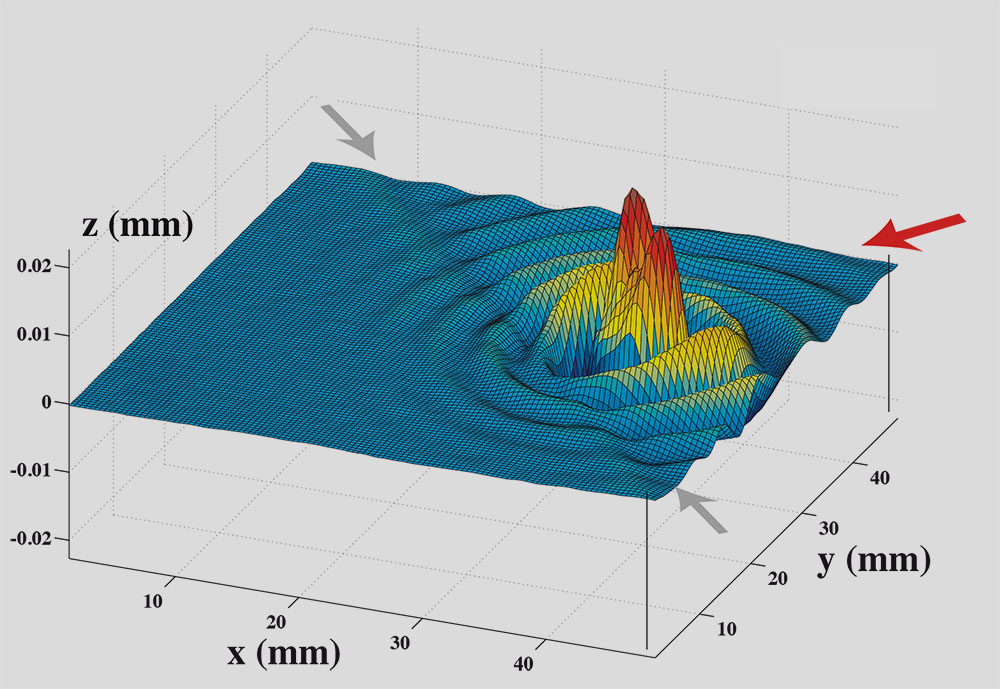
Diffraction and interference
The first question that we addressed [P6] was the following. A walker is formed of an association of a localized object, the drop and an extended structure, the wave. This is a symbiotic association : the waves do not exist if the drop does not generate them and the drop does not move if the waves are damped. When the wave is disturbed for instance by passing through a slit what happens to the drop ? This is why we undertook experiments on the drops trajectories when they pass through apertures limiting the transverse extent of their wave. They were inspired by the founding quantum experiments performed at a low flux of particles. It was shown by G.I. Taylor in 1909 [ref 9] that diffraction or interference patterns could be obtained even when only one single photon was present in the system at a time. These patterns then corresponded to the accumulation of successive individual events and thus reflected a statistical phenomenon. As stated in Feynman’s text-books such results are usually thought to be impossible to understand in a classical way.The aperture is a slit opened in a submarine barrier. As shown on film VI.1 the drop is deflected. We measured the angle of deflection and found that it was not related in a simple way to the region of the slit the drop had crossed. For this reason we had to do statistics.
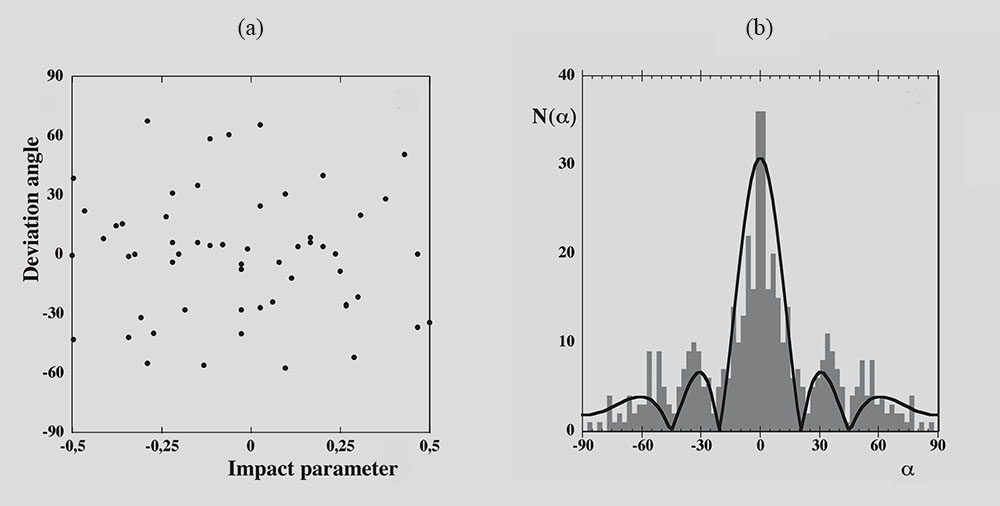
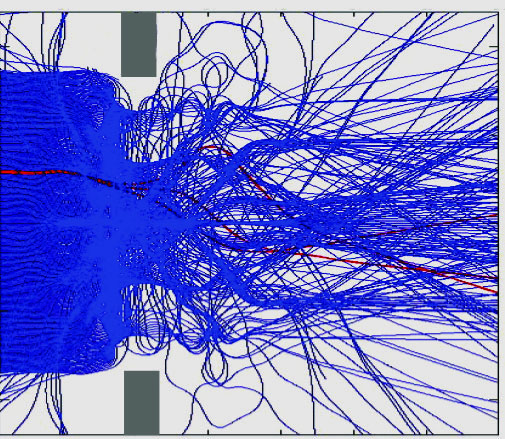
In the present experiment where a similar statistical property is observed its interpretation is simple : while the drop passes through a slit, its pilot wave is sensitive to the whole environment through an echolocation process. Since it is extended in time by memory effects the wave field transfers information to the drop even before it has reached the slit. It is worth noting that several attempts done to repeat this experiment have lead to divergent results [ref 9]. In particular Dan Harris has repeated these experiments in MIT in conditions where the experimental noise is reduced and he does not recover the complex trajectories that we observe both experimentally and numerically in the slit region (see Fig. VI.3). Correlatively his histogram of deviations differs from ours. Obviously more work is needed to understand both the interaction of the walker with the sub-marine boundaries [ref 11] and the role of noise in such experiments.
Tunnel effect
If a walker is enclosed in e.g. a square corral with thick submarine walls, it is trapped with no possible escape as seen in Film VI.2.
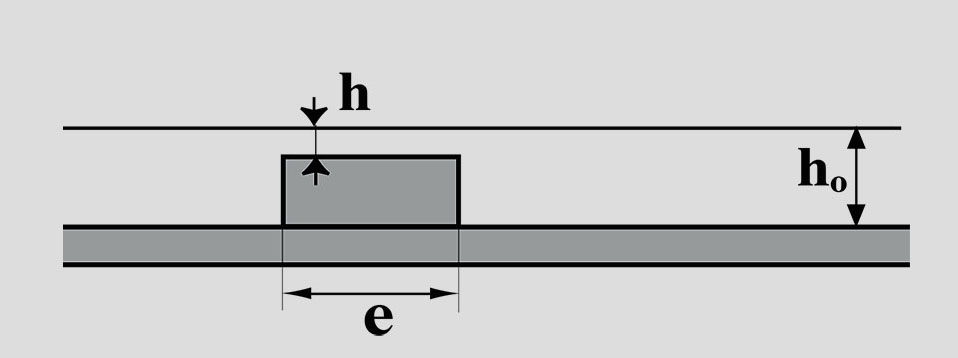

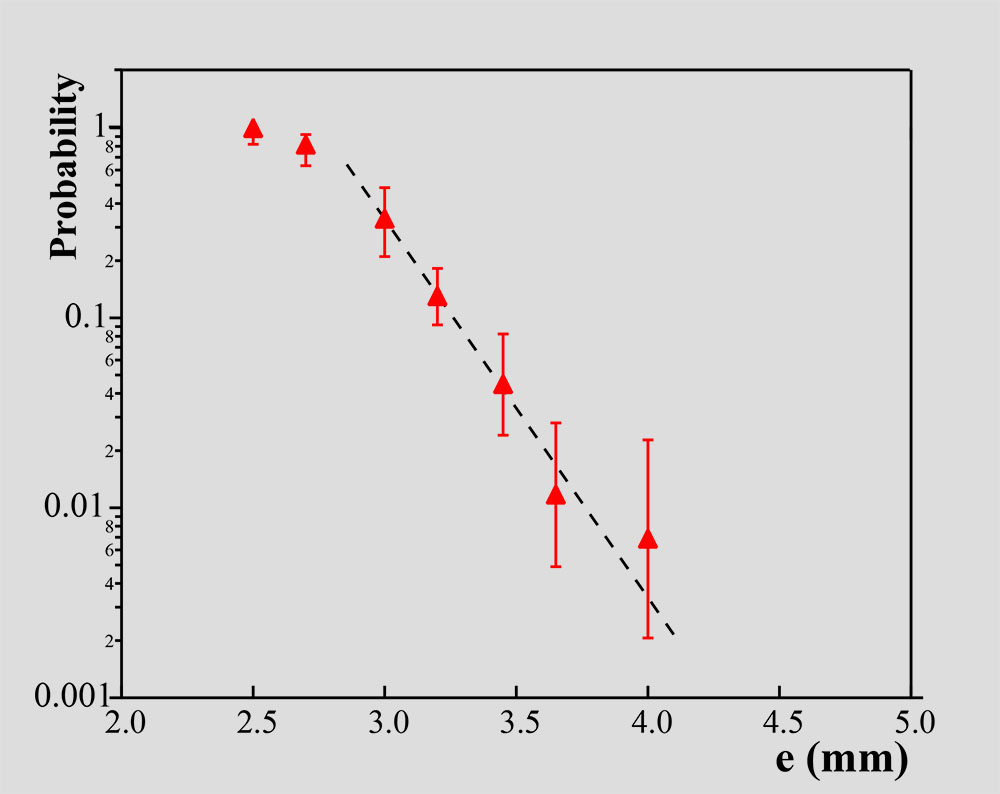
Trajectories in circular corrals
The effect of the confinement of a walker inside a circular corral holds many similarities with the confinement in a potential well that was described in section V.2. This is a non-trivial result since the previous confinement was obtained with a force acting on the drop, while here it is obtained by the effect of the interaction of the waves with the boundaries. At low memory, as shown in film VI.5 the walker follows a circular orbit. In contrast in the high memory regime the trajectory is generally highly chaotic as can be seen in film VI.6. This regime was investigated in a close collaboration with the MIT group headed by John Bush.
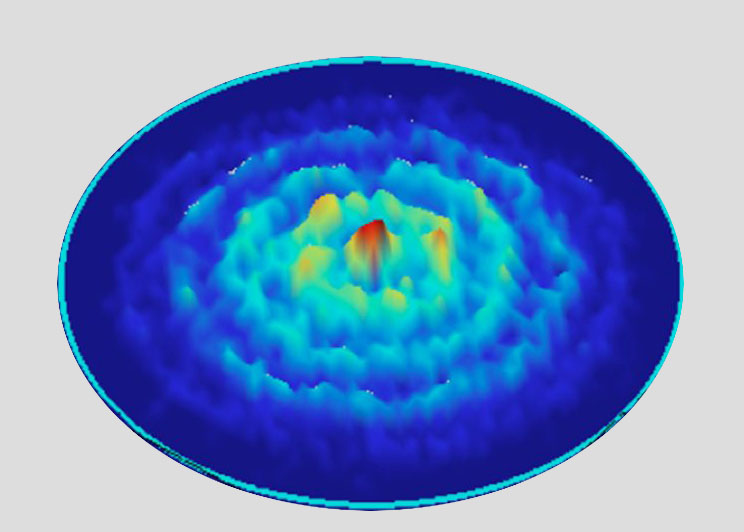
Bibliography
Publications
[P6] Single-Particle Diffraction and interference at a macroscopic scale (PDF)
Y Couder & E.FortPhys. Rev. Lett. , 97, 154101,1-4 (2006)
[P9] Unpredictable tunneling of a classical wave-particle association (PDF)
A. Eddi, E. Fort, F. Moisy & Y. CouderPhys. Rev. Lett., 102, 240401 (2009)
[P15] Probabilities and trajectories in a classical wave-particle duality (PDF)
Y. Couder & E. FortJournal of Physics , 361, 012001 (2012)
[P16] Trajectory eigenmodes of an orbiting wave source (PDF)
E. Fort & Y. CouderEPL, 102, 16005 (2013)
[P17] Wavelike statistics from pilot-wave dynamics in a circular corral (PDF)
D. Harris, J.Moukhtar, E.Fort, Y. Couder & J. BushPhys. Rev. E, 88, 011001 (2013)
[P20] Non-Hamiltonian features of a classical pilot-wave dynamics (PDF)
M Labousse, S PerrardPhys. Rev. E, 90 , 022913 (2014)
Thesis
[T2] Marcheurs, dualité onde-particule et Mémoire de chemin (PDF)
Antonin Eddi, Thèse de Doctorat de l’Université Paris-Diderot (2 Février 2011)
References
[ref 1] Recherches sur la théorie des quanta
de Broglie L.Annales de Physique , 10-III, 22-128 (1925) - English translation (Kracklauer A.F. 2004)
[ref 2] La mécanique ondulatoire et la structure atomique de la matière et du rayonnement
de Broglie L.Journal de Physique et le radium , 6-5, 225-241 (1927) - English translation (Kracklauer A.F. 2004)
[ref 3] A suggested interpretation of quantum theory in terms of hidden variables. Part 1 and part 2
Bohm D.Phys. Rev , 85, 166-193 (1952)
[ref 4] Scientific Papers Presented to Max Born on his retirement from the Tait Chair of Natural Philosophy in the University of Edinburgh
de Broglie L.Oliver and Boyd (1953) - English translation (Dileep Karanth 2010)
[ref 5] L’interprétation de la mécanique ondulatoire
de Broglie L.Journal de Physique et le radium , 20, 963-979 (1959)
[ref 6] Quantum interference and the quantum potential
Philippidis C., Dewdney C. and Hiley B. J.Nuovo Cimento , B52, 15-28 (1979)
[ref 7] Observing the average trajectories of single photons in a two-slit interferometer
Kocsis S., Braverman B., Ravets S., Stevens M. J., Mirin R., P. Shalm L. K. and Steinberg A.M.Science , 332, 1179-1173 (2011)
[ref 8] Double-slit experiment with single wave-driven particles and its relation to quantum mechanics
Andersen A., Madsen J., Reichelt C., Rosenlund Ahl S., Lautrup, B., Ellegaard C., Levinsen M. T, and Bohr T.Phys. Rev. E , 92, 013006 (2015)
[ref 9] Interference Fringes with Feeble Light
Taylor G. I.Proc. Cambridge Philos. Soc. , 15, 114 (1909)
[ref 10] Dynamics and statistics of wave-particle interactions in a confined geometry
Gilet T.Phys. Rev. E , 90, 052917 (2014)
[ref 11] Non-specular reflection of walking droplets
Pucci G., Saenz P.J., Faria L. & Bush J.W.M.J. Fluid Mech., 804, R3, 1-12 (2016)
[ref 12] Pilot-wave hydrodynamics
Bush J.W.MAnn. Rev. Fluid Mech. 49, 269-292 (2015).